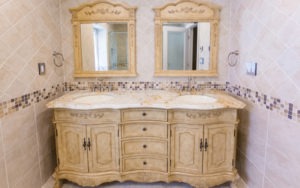You may have seen elegantly carved natural stone sinks in high-end design magazines or websites. The elegant, organic edges and color variations in natural stone are certainly stunning, though the reality is these kinds of sinks are more form and less function. Natural stone is a difficult material to use for sinks because most varieties have a tough time holding up to sudden temperature variations and residue from cleaners and other common substances, such as makeup, shaving cream, and soaps. So, are there any kind of stone sinks that might be good for regular home use?
Why Granite Composite Sinks Are a Better Option
Yes! The answer is stone composite, particular granite composite sinks. These are made from ground granite dust and an acrylic resin that binds the dust together. The mixture is then placed into a mold — in this case, a sink-shaped mold — where it is left to cure. Depending on the manufacturer, the sinks are then sealed and polished to a high-gloss, or left with a honed (matte) finish.
Although natural granite has an extraordinary ability to withstand heavy loads and high pressures without breaking or chipping, is resistant to degradation by water and acids, and can handle some degree of temperature variation without breaking or chipping, natural granite sinks are still only appropriate for very light usage, and little usage beyond normal hand washing. This is because granite is still porous and can absorb moisture over time even when sealed, and it can still break or crack if it experiences an extreme temperature shock. If you think that’s unlikely, think about when you strain pasta into a kitchen sink — that boiling water hitting the cold or room-temperature sink can certainly result in a crack that may be very difficult to repair.
It’s also worth noting that although you may have seen stunning marble sinks in magazines or home stores, it’s actually a very poor material to use for this purpose. Marble is prone to degradation and etching from acids and common household cleaners, and it’s incredibly porous and will absorb water and moisture more readily than other stones. Because a stone sink will come into contact with water frequently, this may cause any iron deposits in the stone to oxidize and stain, which can also occur if any metal fixtures begin to rust near the marble as well. Finally, a marble sink will easily chip and break from temperature shocks. So, unless you’re ok with a marble sink that is there for looks rather than even light usage, you’d be much better off investing in a marble slab for your kitchen. Otherwise, you’re basically buying a marble paper weight for your bathoom!
Because granite composite sinks are made with an acrylic resin, they’re able to withstand sudden temperature differentials and also resist scratches, stains and chips better than both stainless steel or porcelain. It’s important to note, though, that although these sinks do a have a stone-like texture, it won’t have the same color variation or grain like natural granite does. Rather, composite granite sinks are uniform in color, though there is a wide range of colors to choose from. In addition, composite sinks tend to be a whole lot cheaper than a sink hewn from a stone slab, not to mention they are virtually maintenance-free. Depending on the manufacturer, you may only need to seal it once a year, if that, in order to protect it from wear and tear.
Stone Sink Maintenance and Practical Advice
There are a lot of things to consider when choosing a stone sink, the most important being how much usage it will get. While natural stone sinks do exist and can look breathtaking when installed, they are fragile and almost always unable to keep up with average home usage. For a similar look at a lower price point, composite sinks will give you beauty and durability for many years to come. Do you have a natural or composite stone sink in your home? Tell us all about it in the comments!

